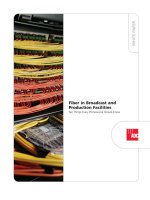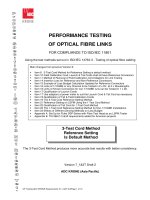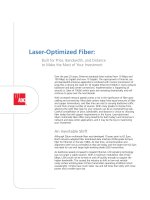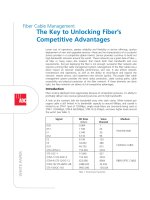Tài liệu ADC KRONE - GUIDE - Planning for 10GbE networks docx
Bạn đang xem bản rút gọn của tài liệu. Xem và tải ngay bản đầy đủ của tài liệu tại đây (304.26 KB, 4 trang )
Planning for 10Gbps Ethernet
over UTP
Questions to Ask When Planning the Cabling Plant
WHITE PAPER
Planning a copper cabling plant to support 10Gbps
transmission is complicated today by the absence of
ratified standards. There are, however, some questions
you can ask that can help navigate promises and claims in
the market place and, ultimately, help you select the
proper infrastructure to support future 10Gbps UTP
applications.
Do you really need a cabling plant that can
support 10Gbps Ethernet over UTP?
Historically speaking, cabling installed has always led the
primary data rate. For example, over 90% of switch port
sales in 1995 were for the 10Mbps Ethernet protocol. Yet
in that same year, the primary UTP cabling installed was
the 100Mbps Category 5, accounting for nearly 70% of
UTP installed market share.
Similarly in 2001, about 70% of switch port sales were for
100Mbps. In the same year, Category 5e and Category 6,
which both support 1000Mbps, accounted for over 80%
of UTP cabling installed.
Of course, the next logical step in the data rate is another
tenfold increase to 10Gbps. With 10Gbps copper
transceivers in development today and expected to market
in 2006, the cabling plant must be able to handle the new
protocol.
Can Category 6 cabling support 10Gbps
Ethernet over UTP?
Actually, Category 6 cabling can support 10Gbps
transmission – but only to 55 metres, per TIA TR42.7,
Cat 6–TSB155. However, this is a costly proposition. The
added construction costs for more telecom rooms to
accommodate 55 metres (vs. the standard 100 metres)
are nominal compared to the added costs of purchasing
additional Ethernet switches and other active equipment
for each additional telecom room to support data, VoIP
or other applications.
What draft standards are important?
Clearly, a 10Gbps UTP cabling solution should support the
full 100 metres. From a standards perspective, TIA TR42.7,
Cat A6-568 B.2 Addendum 10 is the current (May 2005)
view to support 10Gbps transmission over UTP at 100
metres. Look for compliance with this standard as you
shop for a solution. The draft standards also require full
interoperability and backwards compatibility.
What about shielded solutions?
Space, time and cost constraints were the drivers that led
to the development of UTP cabling in lieu of shielded
twisted pair (STP) solutions. Those reasons are still
prevalent today. Still there are manufacturers that do not
yet have a UTP solution and are promoting STP shielded
solutions for 10Gbps transmission over copper. However,
shielded cabling typically requires more space in racks,
cabinets, and raceways. Furthermore, grounding and
bonding is a concern for shielded cable installations. Time
to train and whether or not to ground at the station and
the closet varies geographically and by whom you ask.
Shielded cable construction will continue to be more costly
than UTP cable construction, as well as more expensive to
install. In fact, a recent ADC KRONE study concluded that
an STP network would typically cost three times more than
a UTP network.
Without TIA/EIA standards in place, what are
good decision criteria for selecting a 10Gbps
solution for UTP?
The cabling industry – TIA/EIA, does not drive the electrical
parameters needed to run transmission protocols. It is the
IEEE that develops proposed protocols, understands what
is needed from an electrical perspective, and then gives
TIA/EIA responsibility for developing measurable
parameters for the cable and connectors.
When in doubt, follow the IEEE lead.
The IEEE 802.3 Study Group was formed to discuss how
best to approach running 10Gbps transmission over a
copper infrastructure. This group is composed of
representatives from chip manufacturers, switch
manufacturers, and cabling and connectivity
manufacturers. Discussions within the group include
which protocol encoding to use and how it relates to the
needed bandwidth or frequency range of the cabling
infrastructure. As of this writing (May 2005), it appears as
though the IEEE Study Group has recommended a
frequency range out to 500 MHz.
A key measurement established by this IEEE study group is
Shannon’s Capacity. Shannon’s Capacity is a measure of
how efficiently a cable can transmit data at different rates,
expressed in bits per second. The IEEE 802.3 Study Group
concluded that achieving 10Gbps transmission at 100
metres requires at least 18Gbps from the cabling solution.
The additional capacity is required to compensate for
active hardware noise parameters such as jitter and
quantisation. Realising that the cabling plant is designed to
support the requirements of active electronics, a
Shannon’s Capacity of at least 18Gbps is a good measure
to consider when evaluating 10Gbps UTP solutions. ADC
KRONE’s CopperTen™ 10Gbps UTP solution
demonstrated 21Gbps over 100 metres for the IEEE
802.3 Study Group in August 2003, easily exceeding the
Shannon’s Capacity minimum requirement of 18Gbps for
all pair combinations. Today, CopperTen has achieved
greater than 31 Gbps over 100 metres, offering more
than enough additional throughput to handle noise
induced by active electronics.
Have vendors had a tough time achieving
10Gbps over UTP at 100 metres?
Yes. By August 2003, the IEEE 802.3 Study Group had
seen no vendor UTP solution that could deliver 18Gbps
Planning for 10Gbps Ethernet over UTP
Page 2
Planning for 10Gbps Ethernet over UTP
Page 3
over UTP at 100 metres. In fact, the apparent lack of
vendor solutions led the IEEE Study Group to three
possible recommendations: lower the data rate to
2.5Gbps for Category 6 UTP; reduce the length of the
supported channel to 55 metres from the industry
standard 100 metres for Category 6 UTP; and use
shielded solutions and abandon UTP as a transport
medium for 10Gbps over copper.
ADC KRONE took on the challenge and returned to the
IEEE 802.3 Study Group just weeks later to demonstrate
CopperTen, the first augmented Category 6 cable
capable of transmitting at least 18Gbps over 100 metres.
After this demonstration, the IEEE 802.3 Study Group
voted 64 to 0 to move forward with a 10Gbps solution
over UTP at 100 metres.
What is the biggest challenge to achieving a
minimum of 18Gbps over UTP?
For Category 5e and Category 6 solutions, the
pair-to-pair relationship is paramount to making good
cable. While these electrical characteristics remain
important, taming alien crosstalk remains the
toughest hurdle for any 10Gbps UTP solution at 100
metres.
Alien crosstalk is the noise heard on a pair within a
cable that is generated by another cable directly
adjacent to it. Manufacturers of active equipment do
not like random events such as alien crosstalk. While
noise between pairs within a cable can be predicted
and eliminated within the active hardware,
unpredictable alien crosstalk cannot.
Crosstalk between pairs in a single UTP cable is often
cancelled out by varying the twist rate between
different pairs and increasing the distance between
pairs. The often-used star filler of Category 6 cable
creates separation by pushing pairs within the cable as
close to the jacket as possible. While this design
reduces crosstalk between pairs within the same cable,
it leaves some pair combinations between cables in the
bundle susceptible to high levels of crosstalk. This
problem is magnified at the higher frequencies of 500
MHz to 625 MHz of 10Gbps transmission.
Instead of using the typical star filler, ADC KRONE’s
CopperTen
™
uses an elliptical offset star filler that
achieves a high degree of separation between pairs in
adjacent cables in a bundle. The shape of the
elongated star filler results in an oblique shape for
each cable. Bundled cables now have sufficient
separation between same lay length pairs to prevent
alien crosstalk. In a bundle, the random separation of
cables keeps cable pairs of the same twist rate within
different cables at a greater distance from one
another, reducing alien crosstalk. Because alien
crosstalk presents the steepest challenge to 10Gbps
over UTP, insist on seeing test results for the 6-
around-1 cable configuration.
How should warranty promises be evaluated?
Until 568B.2 is ratified, it is impossible for any vendor to
guarantee full compliance to a standard that does not yet
exist. Until standards are established, it is more important
for a 10Gbps UTP solution to meet the throughput and
capacity requirements established by the electronics
industry – Shannon’s Capacity of 18Gbps. As the
standards evolve, manufacturers will continually tweak
individual parameters such as NEXT and return loss, as
we saw with Category 5e and Category 6. Still, the only
hard design number for 10Gbps over UTP todays 18Gbps
throughput as defined by IEEE.
ADC KRONE offers a warranty that backs 18Gbps
channel capacity and supports the current draft of
568B.2 Addendum 10.
Is cable diameter an issue with 10Gbps UTP
solutions?
Larger cable diameters can affect not only density but
also ease of installation and maintenance. To achieve the
requirements of draft standards for 10Gbps transmission
over UTP, some manufacturers today have 10Gbps UTP
cable with outside diameters (OD) ranging from 8mm to
8.5mm – rather large in comparison to the nominal size
for conduit fill of 7.5mm for the plenum CopperTen,
which has a varying OD from 7mm to 8mm due to its
elliptical shape.
Outside diameter is also a consideration for patch cords.
ADC KRONE’s CopperTen patch cord cable has an OD of
7mm, which is dramatically smaller when compared to
the OD of the competitive cable which range from 8mm
to 8.5mm.
While these differences seem small, they become
significant installation and maintenance issues, especially
in dense applications.
Are patch cords changing for 10Gbps
transmission?
There is one change to look for when evaluating patch
cords for use in a 10Gbps channel – stranded vs. solid
wire. Some products have moved to solid wire patch
cords to achieve 10Gbps performance. Yet solid
wirepatch cords present concerns. Patch cords that
employ solid wire sacrifice flexibility and bend radii
mechanics because solid wire is not as forgiving and easy
to install or manage as stranded wire. Solid wire patch
cord conductors are more prone to breakage when
repeatedly flexed during normal lifetime usage.
In addition, solid wire patch cords often have reliability
issues due to the difficultly of crimping RJ45 plugs on
solid wire. As compared to stranded wire patch cords,
solid wire patch cords also place unnecessary stress upon
the connectors in NICs, patch panels and switches,
because of their uncompromising stature.
It is evident that 10Gbps transmission over a
copper cabling plant will soon become the
common design specification. While lack of
standards today present some risk in the decision
making process, other factors offer guidance
when choosing cable, plugs and connectors to
support future 10Gbps applications Choosing a
solution of the highest quality offers immediate
evidence of superior performance. Solutions that
can guarantee Shannon’s Capacity of 18Gbps at
100 metres offer the best assurance that the
channel will support 10Gbps transmission when
standards are ratified next year.
WHITE PAPER
ADC Telecommunications, Inc., P.O. Box 1101, Minneapolis, Minnesota USA 55440-1101
Specifications published here are current as of the date of publication of this document. Because we are
continuously improving our products, ADC reserves the right to change specifications without prior notice. At any
time, you may verify product specifications by contacting your local ADC KRONE office. ADC Telecommunications,
Inc. views its patent portfolio as an important corporate asset and vigorously enforces its patents. Products or
features contained herein may be covered by one or more U.S. or foreign patents. An Equal Opportunity Employer.
1325087_au 6/05 © 2002, 2004, 2005 ADC Telecommunications, Inc. All Rights Reserved.
www.adckrone.com/au
AUSTRALIA 2 Hereford Street, Berkeley Vale NSW 2261
Mailing Address: PO Box 335, Wyong NSW 2259, Australia
TECH SUPPORT 1800 801 298
www.adckrone.com/nz
NEW ZEALAND 2 Nevis Street, Petone, Wellington
Mailing Address: PO Box 38-177, Wellington Mail Centre 6008, New Zealand









